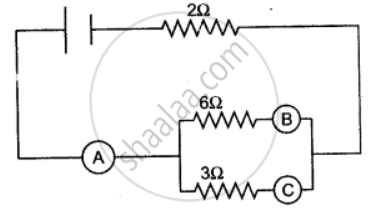Advertisements
Advertisements
प्रश्न
Keeping the resistance constant, the potential difference applied across the ends of a component is halved. By how much does the current change?
उत्तर
From Ohm's law we have:
V / I = R
Or I = V/R
Now, according to the question, the resistance is constant and the potential difference is halved.
i.e. R' = R
and V' = V/2
Then the new current is given by:
I' = V'/R'
= V/2/R
= (1/2) (V/R)
= (1/2) I
It is clear from the above statement that the current becomes half.
APPEARS IN
संबंधित प्रश्न
By what other name is the unit joule/coulomb called?
What do the letters p.d. stand for?
Name a device which helps to maintain potential difference across a conductor (say, a bulb).
In the figure given below, A, B and C are three ammeters. The ammeter B reads 0.5A. (All the ammeters have negligible resistance.)

Calculate:
(i) the readings in the ammeters A and C.
(ii) the total resistance of the circuit.
If P and V are the power and potential of device, the power consumed with a supply potential V1 is:
Electric potential is a ____________.
How will you conclude that the same potential difference (voltage) exists across three resistors connected in a parallel arrangement to a battery?
Assertion (A): Charges flow from higher potential to lower potential.
Reason (R): Current flows mainly due to the flow of electrons.
What is the measure of the work done on the unit positive charge to bring it to that point against all electrical forces?
Find the potential difference required to flow a current of 300 mA in a wire of resistance 20 Ω.
